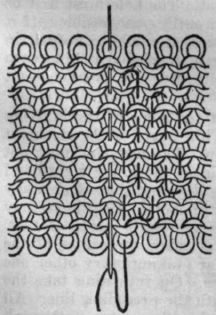
Due to the textile origin of the term tantra (from tan- 'to weave'), one might suggest the idea that it denoted at first the "texture" (note the same metaphor at work in "text") of a ritual, upon which successive rites could have been applied exactly as different kinds of weaving could be woven on the same rough warp.
Jan Gonda analogously emphasises the textile imagery on which this ritual terminology is based, by mentioning «the distinction between the ‘warp’ (tantra) and the ‘woof’ (āvāpa) of a sacrificial rite, that is of the framework, standing model, or those components which has in common with other rites and those that vary from ritual to ritual and are therefore the special characteristic features» (Gonda 1977:510).
Unfortunately, a lexica mention 'woof' as a possible meaning of āvāpa and the etymology supports it, I do not know of any attestation of āvāpa bearing this meaning if not in the context of a contrast to tantra.
How much does this pre-history influence the later history of tantra as "Sacred Text"?
On tantra, see here.


6 comments:
āvāpa 'woof' didn't seem make it into Pāli (where the word occurs but means 'furnace, oven').
However in his commentary on the Kālāma Sutta Buddhaghosa (writing in Sri Lanka) uses the phrase "piṭaka-tantiyā saddhim sametīti" 'collections of sacred teachings together with what is learnt' (or something like that), to gloss the phrase "piṭaka-sampadāna" 'handing on of collections' in the text. Pāli tanta = Saṃskṛta tantra. He seems to see "tantra" as a sacred text ca. 5th CE.
I've not seen this remarked on by any scholars, but it surely predates the consensus dates for the Tantric movement in the North, doesn't it?
Certainly tantra seems to be a synthesis - a weaving together of many strands of Indian religious belief and practice into something new. I like the idea (was it Davidson?) that it came partly as a response to the falling apart of the Gupta empire. Indian society needed re-weaving after that.
Are there many textile-related metaphors in Sanskrit literature?
@Jayarava,
I did not realise (or maybe forgot) that Davidson deemed that the renewal connected with the beginning of tantrism had lead also to the name "tantra" as a new warp for the Indian world. I have always thought of tantra just as "Sacred Text", with "tantrism" becoming a proper name for a distinct movement only in the scholarship about it.
I am not claiming that nothing like "tantrism" as a movement ever existed, but that it did not have a unitary name. Moreover, many of its most influential schools (such as most Śaiva ones, as far as I know) rather speak of Āgamas, etc. Therefore, "tantra" was just one of the names to designate the Sacred Texts current in these schools. But the fact that the schools claimed to have further Sacred Texts on top of/instead of the Veda was quite revolutionary.
@Cherine,
well, yes. Apart from the important imagery related to tantra and āvāpa (the ritual is constantly paragonated to the warp, with occasional insertions being the woof), another key-term in Sanskrit literature, i.e., sūtra, has a textile origin. You probably remember that sūtra designates either the short aphorisms used in Grammar, etc., or the (often quite long) speeches attributed to the Buddha. In order to make sense of these two usages Konrad Klaus suggested that it primarily indicates the thread on which words are collocated, like the string of a perl-necklace.
By contrast, I am sorry to say that I am no expert on textual imageries in kāvya. Do you know about them?
@Cherine,
I forgot to mention a significant case, i.e., the fact that "to sacrifice" might be said with the root tan-, literally to extend, to weave.
Thanks Elisa,I'll pass on your info. on Sanskrit textile metaphors to some of the textile researchers whom I work for, as we've been discussing the contexts in which such metaphors appear in various languages. While I don't know Sanskrit myself, I do hope some of your readers would ponder on the subject and post more examples on your blog,as it is quite a fascinating topic.
Post a Comment